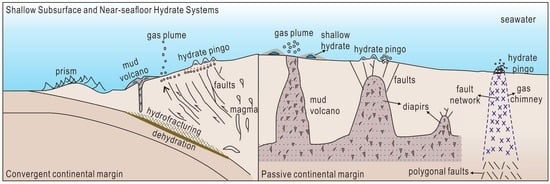Gas Sources, Migration, and Accumulation Systems: The Shallow Subsurface and Near-Seafloor Gas Hydrate Deposits
Abstract
:1. Introduction
2. Fault-Chimney-Controlled Deposits
2.1. Joetsu Basin, Japan
2.2. Ulleung Basin, Korea
2.3. Barents Sea
2.4. Mid-Norwegian Margin
2.5. Conclusion to This Section
3. Diapir-Fault-Controlled Deposits
3.1. Krishna–Godavari Basin, India
3.2. Northern Gulf of Mexico
3.3. Offshore Angola
3.4. Blake Ridge Diapir
3.5. Conclusions to This Section
4. Fault-Controlled Deposits
4.1. Southern Hydrate Ridge
4.2. The Bullseye Cold Vent
4.3. Barkley Canyon
4.4. Conclusion to This Section
5. Submarine Mud Volcano-Controlled Deposits
6. Other Cases
7. Significant Issues for the Shallow Subsurface and Near-Seafloor Gas Hydrate Deposits
7.1. Classification
7.2. Prerequisites of Formation and Stability of Hydrate Mounds and Pingoes
7.3. Gas Migration through the GHSZ
7.4. Gas Source and High Geothermal Condition
7.5. Ecological and Economic Effects
8. Conclusions
Author Contributions
Funding
Institutional Review Board Statement
Informed Consent Statement
Data Availability Statement
Acknowledgments
Conflicts of Interest
References
- Boswell, R.; Collett, T.S.; Frye, M.; Shedd, B.; Shelander, D. Subsurface gas hydrates in the northern Gulf of Mexico. Mar. Pet. Geol. 2012, 34, 4–30. [Google Scholar] [CrossRef]
- Wu, N.Y.; Su, M.; Xu, H.N.; Liu, C.L.; Hu, G.w.; Qiao, S.H.; Yang, R.; Huang, L.; Liu, J.; Li, C.F. Gas Hydrate Migration and Accumulation System: Theory, Method and Practice; Anhui Science and Technology Press: Anhui, China, 2020. (In Chinese) [Google Scholar]
- Boswell, R.; Collett, T. The Gas Hydrates Resource Pyramid. Fire in the Ice. In Methane Hydrate Newsletter; US Department of Energy, Office of Fossil Energy, National Energy Technology Laboratory: Pittsburgh, PA, USA, 2006; pp. 1–16. [Google Scholar]
- Liu, L.P.; Sun, Z.L.; Zhang, L.; Wu, N.Y.; Qin, Y.C.; Jiang, Z.Z.; Geng, W.; Cao, H.; Zhang, X.L.; Zhai, B.; et al. Progress in Global Gas Hydrate Development and Production as a New Energy Resource. Bull. Geol. Soc. China 2019, 93, 731–755. [Google Scholar] [CrossRef]
- Matsumoto, R.; Ryu, B.J.; Lee, S.R.; Lin, S.; Wu, S.G.; Sain, K.; Pecher, I.; Riedel, M. Occurrence and exploration of gas hydrate in the marginal seas and continental margin of the Asia and Oceania region. Mar. Pet. Geol. 2011, 28, 1751–1767. [Google Scholar] [CrossRef]
- Horozal, S.; Lee, G.H.; Yi, B.Y.; Dong, G.Y.; Park, K.P.; Lee, H.Y.; Kim, W.; Han, J.K.; Lee, K. Seismic indicators of gas hydrate and associated gas in the Ulleung Basin, East Sea (Japan Sea) and implications of heat flows derived from depths of the bottom-simulating reflector. Mar. Geol. 2009, 258, 126–138. [Google Scholar] [CrossRef]
- Kang, N.K.; Yoo, D.G.; Bo, Y.Y.; Ryu, B.J.; Lee, S.R. Seismic chimneys associated with gas hydrates in the Ulleung Basin, East Sea of Korea. In Proceedings of the 7th Internal Conference on Gas Hydrate, Scotland, UK, 17–21 July 2011. [Google Scholar]
- Yoo, D.G.; Kang, N.K.; Yi, B.Y.; Kim, G.Y.; Ryu, B.J.; Lee, K.; Lee, G.H.; Riedel, M. Occurrence and seismic characteristics of gas hydrate in the Ulleung Basin, East Sea. Mar. Pet. Geol. 2013, 47, 236–247. [Google Scholar] [CrossRef]
- Matsumoto, R.; Tanahashi, M.; Kakuwa, Y.; Snyder, G.; Ohkawa, S.; Tomaru, H.; Morita, S. Recovery of thick deposits of massive gas hydrates from gas chimney. Fire Ice 2017, 17, 1–6. [Google Scholar]
- Freire, A.F.M.; Matsumoto, R.; Akiba, F. Geochemical analysis as a complementary tool to estimate the uplift of sediments caused by shallow gas hydrates in mounds at the seafloor of Joetsu Basin, eastern margin of the Japan Sea. J. Geol. Res. 2012, 2012, 839840. [Google Scholar] [CrossRef]
- Matsumoto, R.; Okuda, Y.; Hiruta, A.; Tomaru, H.; Takeuchi, E.; Sanno, R.; Suzuki, M.; Tsuchinaga, K.; Ishida, Y.; Ishizaki, O.; et al. Formation and collapse of gas hydrate deposits in high methane flux area of the Joetsu basin, eastern margin of Japan sea. J. Geogr. 2009, 118, 43–71, (In Japanese with abstract in English). [Google Scholar] [CrossRef]
- Hiruta, A.; Snyder, G.T.; Tomaru, H.; Matsumotoa, R. Geochemical constraints for the formation and dissociation of gas hydrate in an area of high methane flux, eastern margin of the Japan Sea. Earth Planet. Sci. Lett. 2009, 279, 326–339. [Google Scholar] [CrossRef]
- Snyder, G.T.; Sano, Y.; Takahata, N.; Matsumoto, R.; Kakizaki, Y.; Tomaru, H. Magmatic fluids play a role in the development of active gas chimneys and massive gas hydrates in the Japan Sea. Chem. Geol. 2020, 535, 119462. [Google Scholar] [CrossRef]
- Freire, A.M.F.; Matsumoto, R.; Santos, L.A. Structural-stratigraphic control on the Umitaka Spur gas hydrates of Joetsu Basin in the eastern margin of Japan Sea. Mar. Pet. Geol. 2011, 28, 1967–1978. [Google Scholar] [CrossRef]
- Nguyen, B.T.T.; Kido, M.; Okawa, N.; Fu, H.; Kakizaki, S.; Imahori, S. Compaction of smectite-rich mudstone and its influence on pore pressure in the deepwater Joetsu Basin, Sea of Japan. Mar. Pet. Geol. 2016, 78, 848–869. [Google Scholar] [CrossRef]
- Matsumoto, R.; Kakuwa, Y.; Snyder, G.T.; Tanahashi, M.; Yanagimoto, Y.; Morita, S. Verification and recovery of thick deposits of massive gas hydrate from chimney structures, eastern margin of Japan Sea. In Proceedings of the AGU Fall Meeting, San Francisco, CA, USA, 11–15 December 2016. [Google Scholar]
- Snyder, G.T.; Hiruta, A.; Matsumoto, R.; Dickens, G.R.; Tomaru, H.; Takeuchi, R.; Komatsubara, J.; Ishida, Y.; Yu, H. Pore water profiles and authigenic mineralization in shallow marine sediments above the methane-charged system on Umitaka Spur, Japan Sea. Deep. Sea Res. Part II Top. Stud. Oceanogr. 2007, 54, 1216–1239. [Google Scholar] [CrossRef]
- Tomaru, H.; Lu, Z.; Snyder, G.T.; Fehn, U.; Hiruta, A.; Matsumoto, R. Origin and age of pore waters in an actively venting gas hydrate field near Sado Island, Japan Sea: Interpretation of halogen and 129I distributions. Chem. Geol. 2007, 236, 350–366. [Google Scholar] [CrossRef]
- Shakirov, R.B.; Syrbu, N.S.; Obzhirov, A.I. Distribution of helium and hydrogen in sediments and water on the Sakhalin slope. Lithol. Miner. Resour. 2016, 51, 61–73. [Google Scholar] [CrossRef]
- Riedel, M.; Bahk, J.J.; Scholz, N.A.; Ryu, B.J.; Yoo, D.G.; Kim, W.; Kim, G.Y. Mass-transport deposits and gas hydrate occurrences in the Ulleung Basin, East Sea-Part 2: Gas hydrate content and fracture-induced anisotropy. Mar. Pet. Geol. 2012, 35, 75–90. [Google Scholar] [CrossRef]
- Ryu, B.J.; Riedel, M.; Kim, J.H.; Hyndman, R.D.; Lee, Y.J.; Chung, B.H.; Kim, I.S. Gas hydrates in the western deep-water Ulleung Basin, East Sea of Korea. Mar. Pet. Geol. 2009, 26, 1483–1498. [Google Scholar] [CrossRef]
- Ryu, B.J.; Collett, T.S.; Riedel, M.; Kim, G.T.; Chun, J.H.; Bahk, J.J.; Lee, J.Y.; Kim, J.H.; Yoo, D.G. Scientific results of the Second Gas Hydrate Drilling Expedition in the Ulleung Basin (UBGH2). Mar. Pet. Geol. 2013, 47, 1–20. [Google Scholar] [CrossRef]
- Lee, G.H.; Suk, B.C. Latest Neogene-Quaternary seismic stratigraphy of the Ulleung Basin, East Sea (Sea of Japan). Mar. Geol. 1998, 146, 205–224. [Google Scholar] [CrossRef]
- Riedel, M.; Collett, T.S.; Kim, H.S.; Bahk, J.J.; Kim, J.H.; Ryu, B.J.; Kim, G.Y. Large-scale depositional characteristics of the Ulleung Basin and its impact on electrical resistivity and Archie-parameters for gas hydrate saturation estimates. Mar. Pet. Geol. 2013, 47, 222–235. [Google Scholar] [CrossRef]
- Scholz, N.A.; Riedel, M.; Bahk, J.J.; Yoo, D.G.; Ryu, B.J. Mass transport deposits and gas hydrate occurrences in the Ulleung Basin, East Sea-Part 1: Mapping sedimentation patterns using seismic coherency. Mar. Pet. Geol. 2012, 35, 91–104. [Google Scholar] [CrossRef]
- Ryu, B.J.; Riedel, M. Gas hydrates in the Ulleung Basin, East Sea of Korea. Terr. Atmos. Ocean. Sci. 2017, 28, 943–963. [Google Scholar] [CrossRef]
- Bahk, J.J.; Kim, D.H.; Chun, J.H.; Son, B.K.; Kim, J.H.; Ryu, B.J.; Torres, M.E.; Riedel, M.; Schultheiss, P. Gas hydrate occurrences and their relation to host sediment properties: Results from Second Ulleung Basin Gas Hydrate Drilling Expedition, East Sea. Mar. Pet. Geol. 2013, 47, 21–29. [Google Scholar] [CrossRef]
- Bahk, J.J.; Kim, J.H.; Kong, G.S.; Park, Y.; Lee, H.; Park, Y.J.; Park, K.P. Occurrence of near-seafloor gas hydrates and associated cold vents in the Ulleung Basin, East Sea. Geosci. J. 2010, 13, 371–385. [Google Scholar] [CrossRef]
- Chun, J.H.; Ryu, B.J.; Son, B.K.; Kim, J.H.; Lee, J.Y.; Bahk, J.J.; Kim, H.J.; Woo, K.S.; Nehza, O. Sediment mounds and other sedimentary features related to hydrate occurrences in a columnar seismic blanking zone of the Ulleung Basin, East Sea, Korea. Mar. Pet. Geol. 2011, 28, 1787–1800. [Google Scholar] [CrossRef]
- Torres, M.E.; Kim, J.H.; Choi, J.Y.; Ryu, B.J.; Bahk, J.J.; Riedel, M.; Collett, T.S.; Hong, W.L.; Kastner, M. Occurrence of high salinity fluids asociated with massive near-seafloor gas hydrate deposits. In Proceedings of the 7th International Conference on Gas Hydrates (ICGH 2011), Edinburgh, Scotland, UK, 17–21 July 2011. [Google Scholar]
- Park, K.P.; Bahk, J.J.; Kwon, Y.; Kim, G.; Riedel, M.; Holland, M.; Schultheiss, P.J.; Rose, K. Korean National Program Expedition Confirms Rich Gas Hydrate Deposit in the Ulleung Basin, East Sea; Spring 2008 Methane Hydrate Newsletter; U.S. Department of Energy, Office of Fossil Energy, National Energy Technology Laboratory: Pittsburgh, DC, USA, 2008; pp. 6–9.
- Hornbach, M.J.; Ruppel, C.; Saffer, D.M.; Dover, C.L.V.; Holbrook, W.S. Coupled geophysical constraints on heat flow and fluid flux at a salt diapir. Geophys. Res. Lett. 2005, 32, L24617. [Google Scholar] [CrossRef]
- Choi, J.; Kim, J.H.; Torres, M.E.; Hong, W.L.; Lee, J.W.; Yi, B.Y.; Bahk, J.J.; Lee, K.E. Gas origin and migration in the Ulleung Basin, East Sea: Results from the Second Ulleung Basin Gas Hydrate Drilling Expedition (UBGH2). Mar. Pet. Geol. 2013, 47, 113–124. [Google Scholar] [CrossRef]
- Kim, J.H.; Torres, M.E.; Choi, J.; Bahk, J.J.; Park, M.H.; Hong, W.L. Inferences on gas transport based on molecular and isotopic signatures of gases at acoustic chimneys and background sites in the Ulleung Basin. Org. Geochem. 2012, 43, 26–38. [Google Scholar] [CrossRef]
- Haacke, R.R.; Hyndman, R.D.; Park, K.P.; Yoo, D.; Stoian, I.; Schmidt, U. Migration and venting of deep gases into the ocean through hydrate-choked chimneys offshore Korea. Geology 2009, 37, 531–534. [Google Scholar] [CrossRef]
- Kim, J.H.; Torres, M.E.; Hong, W.L.; Choi, J.; Riedel, M.; Bahk, J.J.; Kim, S.H. Pore fluid chemistry from the Second Gas Hydrate Drilling Expedition in the Ulleung Basin (UBGH2): Source, mechanisms and consequences of fluid freshening in the central part of the Ulleung Basin, East Sea. Mar. Pet. Geol. 2013, 47, 99–112. [Google Scholar] [CrossRef]
- Mora, G. Isotope-tracking of pore water freshening in the fore-arc basin of the Japan Trench. Mar. Geol. 2005, 219, 71–79. [Google Scholar] [CrossRef]
- Waage, M.; Portnov, A.; Serov, P.; Bünz, S.; Waghorn, K.A.; Vadakkepuliyambatta, S.; Mienert, J.; Andreassen, K. Geological Controls on Fluid Flow and Gas Hydrate Pingo Development on the Barents Sea Margin. Geochem. Geophys. Geosystems 2019, 20, 630–650. [Google Scholar] [CrossRef]
- Waage, M.; Serov, P.; Andreassen, K.; Waghorn, K.A.; Bünz, S. Geological controls of giant crater development on the Arctic seafloor. Sci. Rep. 2020, 10, 8450. [Google Scholar] [CrossRef]
- Serov, P.; Vadakkepuliyambattaa, S.; Mienert, J.; Patton, H.; Portnov, A.; Silyakova, A.; Panieri, G.; Carroll, M.L.; Carroll, J.; Andreassen, K. Postglacial response of Arctic Ocean gas hydrates to climatic amelioration. Proc. Natl. Acad. Sci. USA 2017, 114, 6215–6220. [Google Scholar] [CrossRef]
- Andreassen, K.; Hubbard, A.; Winsborrow, M.; Patton, H.; Vadakkepuliyambatta, S.; Plaza-Faverola, A.; Gudlaugsson, E.; Serov, P.; Deryabin, A.; Mattingsdal, R.; et al. Massive blow-out craters formed by hydrate-controlled methane expulsion from the Arctic seafloor. Science 2017, 356, 948–953. [Google Scholar] [CrossRef]
- Nixon, F.C.; Chand, S.; Thorsnes, T.; Bjarnadóttir, L.R. A modified gas hydrate-geomorphological model for a new discovery of enigmatic craters and seabed mounds in the Central Barents Sea, Norway. Geo-Mar. Lett. 2019, 39, 191–203. [Google Scholar] [CrossRef]
- Rasmussen, T.L.; Thomsen, E.; ŚLubowska, M.A.; Jessen, S.; Solheim, A.; Koç, N. Paleoceanographic evolution of the SW Svalbard margin (76° N) since 20,000 14C yr BP. Quat. Res. 2007, 67, 100–114. [Google Scholar] [CrossRef]
- Anell, I.; Faleide, J.; Braathen, A. Regional tectono-sedimentary development of the highs and basins of the northwestern Barents Shelf. Nor. Geol. Tidsskr. 2016, 96, 27–41. [Google Scholar] [CrossRef]
- Vorren, T.O.; Richardsen, G.; Knutsen, S.M.; Henriksen, E. Cenozoic erosion and sedimentation in the western Barents Sea. Mar. Pet. Geol. 1991, 8, 317–340. [Google Scholar] [CrossRef]
- Paull, C.K.; Ussler, W.; Dallimore, S.R.; Blasco, S.M.; Lorenson, T.D.; Melling, H.; Medioli, B.E.; Nixon, F.M.; McLaughlin, F.A. Origin of pingo-like features on the Beaufort Sea shelf and their possible relationship to decomposing methane gas hydrates. Geophys. Res. Lett. 2007, 34, L01603. [Google Scholar] [CrossRef]
- Serov, P.; Portnov, A.; Mienert, J.; Semenov, P.; Ilatovskaya, P. Methane release from pingo-like features across the South Kara Sea shelf, an area of thawing offshore permafrost. J. Geophys. Res. Earth Surf. 2015, 120, 1515–1529. [Google Scholar] [CrossRef] [Green Version]
- Bünz, S.; Mienert, J.; Bryn, P.; Berg, K. Fluid flow impact on slope failure from 3D seismic data: A case study in the Storegga Slide. Basin Res. 2005, 17, 109–122. [Google Scholar] [CrossRef]
- Hustoft, S.; Mienert, J.; Bünz, S.; Nouzé, H. High-resolution 3D-seismic data indicate focussed fluid migration pathways above polygonal fault systems of the mid-Norwegian margin. Mar. Geol. 2007, 245, 89–106. [Google Scholar] [CrossRef]
- Plaza-Faverola, A.; Bünz, S.; Mienert, J. Fluid distributions inferred from P-wave velocity and reflection seismic amplitude anomalies beneath the Nyegga pockmark field of the mid-Norwegian margin. Mar. Ans Pet. Geol. 2010, 27, 46–60. [Google Scholar] [CrossRef]
- Plaza-Faverola, A.; Westbrook, G.K.; Ker, S.; Exley, R.K.; Gailler, A.; Minshull, T.A.; Broto, K. Evidence from three-dimensional seismic tomography for a substantial accumulation of gas hydrate in a fluid-escape chimney in the Nyegga pockmark field, offshore Norway. J. Geophys. Res. Solid Earth 2010, 115, B08104. [Google Scholar] [CrossRef]
- Hovland, M.; Svensen, H.; Forsberg, C.F.; Johansen, H.; Fichler, C.; Fosså, J.H.; Jonsson, R.; Rueslåtten, H. Complex pockmarks with carbonate-ridges off mid-Norway: Products of sediment degassing. Mar. Geol. 2005, 218, 191–206. [Google Scholar] [CrossRef]
- Mazzini, A.; Aloisi, G.; Akhmanov, G.G.; Parnell, J.; Cronin, B.T.; Murphy, P. Integrated petrographic and geochemical record of hydrocarbon seepage on the Vøring Plateau. J. Geol. Soc. 2005, 162, 815–827. [Google Scholar] [CrossRef]
- Hovland, S.; Svensen, H. Submarine pingoes: Indicators of shallow gas hydrates in a pockmark at Nyegga, Norwegian Sea. Mar. Geol. 2006, 228, 15–23. [Google Scholar] [CrossRef]
- Westbrook, G.K.; Exley, R.; Minshull, T.A.; Nouzé, H.; Gailler, A.; Jose, T.; Ker, S.; Plaza, A. High-resolution 3D seismic investigations of hydrate-bearing fluid escape chimneys in the Nyegga region of the Vøring Plateau, Norway. In Proceedings of the 6th International Conference on Gas Hydrates (ICGH 2008), Vancouver, BC, Canada, 6–10 July 2008. [Google Scholar] [CrossRef]
- Chen, Y.F.; Ussler, W., III; Haflidason, H.; Rise, L.; Hovland, M.; Hjelstuen, B.O. Sources of methane inferred from pore-water δ13C of dissolved inorganic carbon in Pockmark G11, offshore Mid-Norway. Chem. Geol. 2010, 275, 127–138. [Google Scholar] [CrossRef]
- Ivanov, M.; Mazzini, A.; Blinova, V.; Kozlova, E.; Laberg, J.S.; Matveeva, T.; Taviani, M.; Kaskov, N. Seep mounds on the Southern Vring Plateau (offshore Norway). Mar. Pet. Geol. 2010, 27, 1235–1261. [Google Scholar] [CrossRef]
- Cathles, L.M.; Zheng, S.; Chen, D.F. The physics of gas chimney and pockmark formation, with implications for assessment of seafloor hazards and gas sequestration. Mar. Pet. Geol. 2010, 27, 82–91. [Google Scholar] [CrossRef]
- Hovland, M. On the self-sealing nature of marine seeps. Cont. Shelf Res. 2002, 22, 2287–2394. [Google Scholar] [CrossRef]
- Hovland, M.; Heggland, R.; Vries, M.; Tjelta, T.I. Unit-pockmarks and their potential significance for predicting fluid flow. Mar. Pet. Geol. 2010, 27, 1190–1199. [Google Scholar] [CrossRef]
- Senger, K.; Bünz, S.; Mienert, J. First-Order Estimation of In-Place Gas Resources at the Nyegga Gas Hydrate Prospect, Norwegian Sea. Energies 2010, 3, 2001–2026. [Google Scholar] [CrossRef]
- Vaular, E.N.; Barth, T.; Haflidason, H. The geochemical characteristics of the hydrate-bound gases from the Nyegga pockmark field, Norwegian Sea. Org. Geochem. 2010, 41, 437–444. [Google Scholar] [CrossRef]
- Fuex, A.N. The use of stable carbon isotopes in hydrocarbon exploration. J. Geochem. Explor. 1977, 7, 155–188. [Google Scholar] [CrossRef]
- Brekke, T.; Lønne, Ø.; Ohm, S.E. Light hydrocarbon gases in shallow sediments in the northern North Sea. Mar. Geol. 1997, 137, 81–108. [Google Scholar] [CrossRef]
- Gay, A.; Lopez, M.; Ondreas, H.; Charlou, J.L.; Sermondadaz, G.; Cochonat, P. Seafloor facies related to upward methane flux within a Giant Pockmark of the Lower Congo Basin. Mar. Geol. 2006, 226, 81–95. [Google Scholar] [CrossRef]
- Gay, A.; Lopez, M.; Berndt, C.; Séranne, M. Geological controls on focused fluid flow associated with seafloor seeps in the Lower Congo Basin. Mar. Geol. 2007, 244, 68–92. [Google Scholar] [CrossRef]
- Brooks, J.M.; Cox, H.B.; Bryant, W.R.; Kennicutt II, M.C.; Mann, R.G.; McDonald, T.G. Association of gas hydrates and oil seepage in the Gulf of Mexico. Org. Geochem. 1986, 10, 221–234. [Google Scholar] [CrossRef]
- Collett, T.S.; Riedel, M.; Cochran, J.; Boswell, R.; Kumar, P.; Sathe, A. Results of the Indian National Gas Hydrate Program Expedition 01 Initial Reports; Report; Director General of Hydrocarbons, Ministry of Petroleum and Natural Gas: New Delhi, India, 2008.
- Sain, K.; Gupta, H. Gas hydrates in India: Potential and development. Gondwana Res. 2012, 22, 645–657. [Google Scholar] [CrossRef]
- Shukla, K.M.; Collett, T.S.; Kumar, P.; Yadav, U.S.; Boswell, R.; Frye, M.; Riedel, M.; Kaur, I.; Vishwanath, K. National Gas Hydrate Program expedition 02: Identification of gas hydrate prospects in the Krishna-Godavari Basin, offshore India. Mar. Pet. Geol. 2019, 108, 167–184. [Google Scholar] [CrossRef]
- Dewangan, P.; Sriram, G.; Ramprasad, T.; Ramana, M.V.; Jaiswal, P. Fault system and thermal regime in the vicinity of site NGHP-01-10, Krishna-Godavari basin, Bay of Bengal. Mar. Pet. Geol. 2011, 28, 1899–1914. [Google Scholar] [CrossRef]
- Dewangan, P.; Ramprasad, T.; Ramana, M.V.; Mazumdar, A.; Desa, M.; Badesab, F.K. Seabed morphology and gas venting features in the continental slope region of Krishna-Godavari basin, Bay of Bengal: Implications in gas-hydrate exploration. Mar. Pet. Geol. 2010, 27, 1628–1641. [Google Scholar] [CrossRef]
- Rao, G.N.; Mani, K.S. A study on generation of abnormal pressures in KrishnaeGodavari basin. Indian J. Pet. Geol. 1993, 2, 20–30. [Google Scholar]
- Riedel, M.; Collett, T.S.; Kumar, P.; Sathe, A.V.; Cook, A. Seismic imaging of a fractured gas hydrate system in the Krishna-Godavari Basin offshore India. Mar. Pet. Geol. 2010, 27, 1476–1493. [Google Scholar] [CrossRef]
- NIO. Geo-Scientific Investigations of Shallow Sediment in KG Offshore, East Coast; National Institute of Oceanography: Dona Paula, India; NIO/TR-13/2005; p. 103.
- Francisca, F.; Yun, T.S.; Ruppel, C.; Santamarin, J.C. Geophysical and geotechnical properties of near-seafloor sediments in the northern Gulf of Mexico gas hydrate province. Earth Planet. Sci. Lett. 2005, 237, 924–939. [Google Scholar] [CrossRef]
- Sassen, R.; Losh, S.L.; Cathles, L.M.; Roberts, H.H.; Whelan, J.K.; Milkov, A.V.; Sweet, S.T.; DeFreitas, D.A. Massive vein-filling gas hydrate: Relation to ongoing gas migration from the deep subsurface in the Gulf of Mexico. Mar. Pet. Geol. 2001, 18, 551–560. [Google Scholar] [CrossRef]
- Vardaro, M.F.; Macdonald, I.R.; Bender, L.C.; Guinasso, N. Dynamic processes observed at a gas hydrate outcropping on the continental slope of the Gulf of Mexico. Geo-Mar. Lett. 2006, 26, 6–15. [Google Scholar] [CrossRef]
- Solomon, E.A.; Kastner, M.; Jannasch, H.; Robertson, G.; Weinstein, Y.S. Dynamic fluid flow and chemical fluxes associated with a seafloor gas hydrate deposit on the northern Gulf of Mexico slope. Earth Planet. Sci. Lett. 2008, 270, 95–105. [Google Scholar] [CrossRef]
- Salvador, A. Late Triassic-Jurassic paleogeography and origin of Gulf of Mexico basin. Am. Assoc. Pet. Geol. Bull. 1987, 71, 419–451. [Google Scholar] [CrossRef]
- McGookey, D.P. Gulf coast Cenozoic sediments and structure; An excellent example of extra-continental sedimentation. Trans. Gulf Coast Assoc. Geol. Soc. 1975, 25, 104–120. [Google Scholar] [CrossRef]
- Bryant, W.R.; Bryant, J.R.; Feeley, M.H.; Simmons, G.R. Physiographic and bathymetric characteristics of the continental slope, northwest Gulf of Mexico. Geo-Mar. Lett. 1990, 10, 182–199. [Google Scholar] [CrossRef]
- Sager, W.W.; Macdonald, I.R.; Hou, R. Geophysical signatures of mud mounds at hydrocarbon seeps on the Louisiana continental slope, northern Gulf of Mexico. Mar. Geol. 2003, 198, 97–132. [Google Scholar] [CrossRef]
- Cook, D.; D’Onfro, P. Jolliet field thrust structure and stratigraphy Green canyon block 184, offshore Louisiana. Trans. Gulf Coast Assoc. Geol. Soc. 1991, 41, 100–121. [Google Scholar] [CrossRef]
- MacDonald, I.R.; Guinasso, N.L.; Sassen, R.; Brooks, J.M.; Lee, L.; Scott, K.T. Gas hydrate that breaches the sea floor on the continental slope of the Gulf of Mexico. Geology 1994, 22, 699–702. [Google Scholar] [CrossRef]
- Chen, D.F.; Cathles, L.M., III. A kinetic model for the pattern and amounts of hydrate precipitated from a gas steam: Application to the Bush Hill vent site, Green Canyon Block 185, Gulf of Mexico. J. Geophys. Res. Solid Earth 2003, 108, 2058. [Google Scholar] [CrossRef]
- MacDonald, I.R.; Bender, L.C.; Vardaro, M.; Bernard, B.; Brooks, J.M. Thermal and visual time-series at a seafloor gas hydrate deposit on the Gulf of Mexico slope. Earth Planet. Sci. Lett. 2005, 233, 45–59. [Google Scholar] [CrossRef]
- Sassen, R.; Joye, S.; Sweet, S.T.; Defreitas, D.A.; Milkov, A.V.; Macdonald, I.R. Thermogenic gas hydrates and hydrocarbon gases in complex chemosynthetic communities, Gulf of Mexico continental slope. Org. Geochem. 1999, 30, 485–497. [Google Scholar] [CrossRef]
- Simonetti, A.; Knapp, J.H.; Sleeper, K.; Lutken, C.B.; Macelloni, L.; Knapp, C.C. Spatial distribution of gas hydrates from high-resolution seismic and core data, Woolsey Mound, Northern Gulf of Mexico. Mar. Pet. Geol. 2013, 44, 21–33. [Google Scholar] [CrossRef]
- Macelloni, L.; Lutken, C.B.; Garg, S.; Simonetti, A.; D’Emidio, M.; Wilson, R.M.; Sleeper, K.; Lapham, L.L.; Lewis, T.; Pizzi, M.; et al. Heat-flow regimes and the hydrate stability zone of a transient, thermogenic, fault-controlled hydrate system (Woolsey Mound northern Gulf of Mexico). Mar. Pet. Geol. 2015, 59, 491–504. [Google Scholar] [CrossRef] [Green Version]
- Macelloni, L.; Simonetti, A.; Knapp, J.H.; Knapp, C.C.; Lapham, L.L. Multiple resolution seismic imaging of a shallow hydrocarbon plumbing system, Woolsey Mound, Northern Gulf of Mexico. Mar. Pet. Geol. 2012, 38, 128–142. [Google Scholar] [CrossRef]
- Serié, C.; Huuse, M.; Schodt, N.H. Gas hydrate pingoes: Deep seafloor evidence of focused fluid flow on continental margins. Geology 2012, 40, 207–210. [Google Scholar] [CrossRef]
- Andresen, K.J.; Huuse, M.; Schødt, N.H.; Clausen, L.F.; Seidler, L. Hydrocarbon plumbing systems of salt minibasins offshore Angola revealed by three-dimensional seismic analysis. AAPG Bull. 2011, 95, 1039–1065. [Google Scholar] [CrossRef]
- Brownfield, M.E.; Charpentier, R.R. Geology and total petroleum systems of the WestCentral Coastal Province (7203), West Africa. U.S. Geol. Surv. Bull. 2006, 2207, 52. [Google Scholar] [CrossRef]
- Singh, S.C.; Minshull, T.A.; Spence, G.D. Velocity structure of a gas hydrate reflector. Science 1993, 260, 204–207. [Google Scholar] [CrossRef]
- Lucazeau, F.; Brigaud, F.; Bouroullec, J.L. High-resolution heat flow density in the lower Congo basin. Geochem. Geophys. Geosystems 2004, 5. [Google Scholar] [CrossRef]
- Serié, C.; Huuse, M.; Schdt, N. Salt Tectonic Controls on Fluid Flow, Gas Hydrate Occurrence and Surface Heat, Kwanza Basin, Offshore Angola. In Proceedings of the AAPG Annual Convention and Exhibition, Houston, TX, USA, 10–13 April 2011. [Google Scholar]
- Dillon, W.P.; Popenoe, P.; Grow, J.A.; Klitgord, K.D.; Swift, B.A.; Paull, C.K.; Cashman, K.V. Growth faulting and salt diapirism; their relationship and control in the Carolina Trough, Eastern North America. In Studies in Continental Margin Geology; Watkins, J.S., Drake, C.L., Eds.; AAPG Memoir 34; Datapages, Inc.: Tulsa, OK, USA, 1982; pp. 21–46. [Google Scholar] [CrossRef]
- Paull, C.K.; Matsumoto, R.; Wallace, P.J. Gas hydrate sampling on the Blake Ridge and Carolina Rise. In Ocean Drilling Program; Leg 164 Preliminary Report; International Ocean Discovery Program: College Station, TX, USA, 1996. [Google Scholar]
- Paull, C.K.; Ussler, W.; Borowski, W.S.; Spiess, F.N. Methane-rich plumes on the Carolina continental rise: Associations with gas hydrates. Geology 1995, 23, 89–92. [Google Scholar] [CrossRef]
- Taylor, M.H.; Dillon, W.P.; Pecher, I.A. Trapping and migration of methane associated with the gas hydrate stability zone at the Blake Ridge Diapir: New insights from seismic data. Mar. Geol. 2000, 164, 79–89. [Google Scholar] [CrossRef]
- Hornbach, M.J.; Ruppel, C.; Dover, C.V. Three-dimensional structure of fluid conduits sustaining an active deep marine cold seep. Geophys. Res. Lett. 2007, 34, 508–512. [Google Scholar] [CrossRef]
- Borowski, W.S. A review of methane and gas hydrates in the dynamic, stratified system of the Blake Ridge region, offshore southeastern North America. Chem. Geol. 2004, 205, 311–346. [Google Scholar] [CrossRef]
- Matsumoto, R.; Uchida, T.; Waseda, A.; Takeya, S.; Hirano, T.; Yamada, K.; Maeda, Y.; Okui, T. Occurrence, structure, and composition of natural gas hydrate recovered from the Blake Ridge, northwest Atlantic. Proc. Ocean. Drill. Program Sci. Results 2000, 164, 13–28. [Google Scholar] [CrossRef]
- Van Dover, C.L.; Aharon, P.; Bernhard, J.M.; Caylor, E.; Doerries, M.; Flickinger, W.; Gilhooly, W.; Goffredi, S.K.; Knick, K.E.; Macko, S.A.; et al. Blake Ridge methane seeps: Characterization of a soft-sediment, chemosynthetically based ecosystem. Deep. Sea Res. Part I Oceanogr. Res. Pap. 2003, 50, 281–300. [Google Scholar] [CrossRef]
- Egeberg, P.K.; Dickens, G.R. Thermodynamic and pore water halogen constraints on gas hydrate distribution at ODP Site 997 (Blake Ridge). Chem. Geol. 1999, 153, 53–79. [Google Scholar] [CrossRef]
- Paull, C.K.; Lorenson, T.D.; Borowski, W.S.; Ussler, W.; Olsen, K.; Rodriguez, N.M. Isotopic composition of CH4, CO2 species, and sedimentary organic matter within samples from the Blake Ridge: Gas source implications. Proc. Ocean. Drill. Program: Sci. Results 2000, 164, 67–78. [Google Scholar] [CrossRef]
- He, T. Mound and Vent Structures Associated with Gas Hydrates Offshore Vancouver Island: Analysis of Single-Channel and Deep-Towed Multichannel Seismic Data; University of Victoria: Victoria, BC, Canada, 2007. [Google Scholar]
- Suess, E.; Torres, M.E.; Borhmann, G.; Collier, R.W.; Rickert, D.; Goldfinger, C.; Linke, P.; Heuser, A.; Sahling, H.; Heeschen, K.; et al. Sea floor methane hydrates at Hydrate Ridge, Cascadia margin. Geophys. Monogr. Am. Geophys. Union 2001, 124, 87–98. [Google Scholar] [CrossRef]
- Riedel, M.; Scherwath, M.; Röme, M.; Veloso, M.; Heesemann, M.; Spence, G.D. Distributed natural gas venting offshore along the Cascadia margin. Nat. Commun. 2018, 9, 3264. [Google Scholar] [CrossRef]
- Joseph, C.; Campbell, K.A.; Torres, M.E.; Martin, R.A.; Pohlman, J.W.; Riedel, M.; Rose, K. Methane-derived authigenic carbonates from modern and paleoseeps on the Cascadia margin: Mechanisms of formation and diagenetic signals. Palaeogeogr. Palaeoclimatol. Palaeoecol. 2013, 390, 52–67. [Google Scholar] [CrossRef]
- Ji, A.O.; Zhu, T.Y.; Marin-Moreno, H.; Lei, H. How gas-hydrate saturation and morphology control seismic attenuation: A case study from the south Hydrate Ridge. Interpret. 2021, 9, 1–63. [Google Scholar] [CrossRef]
- Riedel, M.; Novosel, I.; Spence, G.D.; Hyndman, R.D.; Chapman, R.N.; Solem, R.C.; Lewis, T. Geophysical and geochemical signatures associated with gas hydrate-related venting in the northern Cascadia margin. Geol. Soc. Am. Bull. 2006, 118, 23–38. [Google Scholar] [CrossRef]
- Crutchley, G.J.; Berndt, C.; Geiger, S.; Klaeschen, D.; Papenberg, C.; Klaucke, I.; Hornbach, M.J.; Bangs, N.L.B.; Maier, C. Drivers of focused fluid flow and methane seepage at south Hydrate Ridge, offshore Oregon, USA. Geology 2013, 41, 551–554. [Google Scholar] [CrossRef]
- Milkov, A.V.; Claypool, G.E.; Lee, Y.J.; Sassen, R. Gas hydrate systems at Hydrate Ridge offshore Oregon inferred from molecular and isotopic properties of hydrate-bound and void gases. Geochim. Cosmochim. Acta 2005, 69, 1007–1026. [Google Scholar] [CrossRef]
- Tréhu, A.M.; Torres, M.E.; Moore, G.F.; Suess, E.; Bohrmann, G. Temporal and spatial evolution of a gas hydrate–bearing accretionary ridge on the Oregon continental margin. Geology 1999, 27, 939–942. [Google Scholar] [CrossRef]
- Tréhu, A.M.; Flemings, P.B.; Bangs, N.L.; Chevallier, J.; Gràcia, E.; Johnson, J.E.; Liu, C.S.; Liu, X.L. Feeding methane vents and gas hydrate deposits at south Hydrate Ridge. Geophys. Res. Lett. 2004, 31, L23310. [Google Scholar] [CrossRef]
- Tréhu, A.M.; Long, P.E.; Torres, M.E.; Bohrmann, G.; Rack, F.R.; Collett, T.S.; Goldberg, D.S.; Milkov, A.V.; Riedel, M.; Schultheiss, P.; et al. Three-dimensional distribution of gas hydrate beneath southern Hydrate Ridge: Constraints from ODP Leg 204. Earth Planet. Sci. Lett. 2004, 222, 845–862. [Google Scholar] [CrossRef]
- Milkov, A.V.; Xu, W. Comment on “Gas hydrate growth, methane transport, and chloride enrichment at the southern summit of Hydrate Ridge, Cascadia margin off Oregon”. Earth Planet. Sci. Lett. 2005, 239, 162–167. [Google Scholar] [CrossRef]
- Torres, M.E.; Wallmann, K.; Tréhu, A.M.; Bohrmann, G.; Borowski, W.S.; Tomaru, H. Gas hydrate growth, methane transport, and chloride enrichment at the southern summit of Hydrate Ridge, Cascadia margin off Oregon. Earth Planet. Sci. Lett. 2004, 226, 225–241. [Google Scholar] [CrossRef]
- Philip, B.T.; Denny, A.R.; Solomon, E.A.; Kelley, D.S. Time-series measurements of bubble plume variability and water column methane distribution above Southern Hydrate Ridge, Oregon. Geochem. Geophys. Geosystems 2016, 17, 1182–1196. [Google Scholar] [CrossRef]
- Daigle, H.; Bangs, N.L.; Dugan, B. Transient hydraulic fracturing and gas release in methane hydrate settings: A case study from southern Hydrate Ridge. Geochem. Geophys. Geosystems 2011, 12, Q12022. [Google Scholar] [CrossRef]
- Boetius, A.; Suess, E. Hydrate Ridge: A natural laboratory for the study of microbial life fueled by methane from near-surface gas hydrates. Chem. Geol. 2004, 205, 291–310. [Google Scholar] [CrossRef]
- Willoughby, E.C.; Mir, R.; Scholl, C.; Edwards, R.N. NEPTUNE-Canada Based Geophysical Imaging of Gas Hydrate in the Bullseye Vent. In Proceedings of the 6th International Conference on Gas Hydrates, Vancouver, BC, Canada, 6–10 July 2008. [Google Scholar] [CrossRef]
- Brown, K.M.; Bekins, B.; Clennell, B.; Dewhurst, D.; Westbrook, G. Heterogeneous hydrofracture development and accretionary fault dynamics. Geology 1994, 22, 259–262. [Google Scholar] [CrossRef]
- Zühlsdorff, L.; Spiess, V. Three-dimensional seismic characterization of a venting site reveals compelling indications of natural hydraulic fracturing. Geology 2004, 32, 101–104. [Google Scholar] [CrossRef]
- Caress, D.W.; Thomas, H.J.; Kirkwood, W.J.; Brewer, P.G. An autonomous multibeam, sidescan, and subbottom survey of a methane hydrate outcrop in Barkley Canyon, offshore Vancouver Island. In Proceedings of the AGU Fall Meeting, San Francisco, CA, USA, 11–15 December 2006. [Google Scholar]
- Chapman, R.; Pohlman, J.; Coffin, R.; Chanton, J.; Lapham, L. Thermogenic gas hydrates in the northern Cascadia margin. Eos Trans. Am. Geophys. Union 2004, 85, 361–368. [Google Scholar] [CrossRef]
- Hester, K.C.; Dunk, R.M.; Walz, P.M.; Peltzer, E.T.; Sloan, E.D.; Brewer, P.G. Direct measurements of multi-component hydrates on the seafloor: Pathways to growth. Fluid Phase Equilibria 2007, 261, 396–406. [Google Scholar] [CrossRef]
- Lu, H.; Seo, Y.T.; Lee, J.W.; Moudrakovski, I.; Ripmeester, J.A.; Chapman, N.R.; Coffin, R.B.; Gardner, G.; Pohlman, J. Complex gas hydrate from the Cascadia margin. Nature 2007, 445, 303–306. [Google Scholar] [CrossRef]
- Pohlman, J.W.; Canuel, E.A.; Chapman, N.R.; Spence, G.D.; Whiticar, M.J.; Coffin, R.B. The origin of thermogenic gas hydrates on the northern Cascadia Margin as inferred from isotopic (13C/12C and D/H) and molecular composition of hydrate and vent gas. Org. Geochem. 2005, 36, 703–716. [Google Scholar] [CrossRef]
- Lapham, L.L.; Chanton, J.P.; Chapman, R.; Martens, C.S. Methane under-saturated fluids in deep-sea sediments: Implications for gas hydrate stability and rates of dissolution. Earth Planet. Sci. Lett. 2010, 298, 275–285. [Google Scholar] [CrossRef]
- Thomsen, L.; Barnes, C.; Best, M.; Chapman, R.; Pirenne, B.; Thomson, R.; Vogt, J. Ocean circulation promotes methane release from gas hydrate outcrops at the NEPTUNE Canada Barkley Canyon node. Geophys. Res. Lett. 2012, 39, L16605. [Google Scholar] [CrossRef]
- Dimitrov, L.I. Mud volcanoes-the most important pathway for degassing deeply buried sediments. Earth-Sci. Rev. 2002, 59, 49–76. [Google Scholar] [CrossRef]
- Milkov, A.V. Worldwide distribution of submarine mud volcanoes and associated gas hydrates. Mar. Geol. 2000, 167, 29–42. [Google Scholar] [CrossRef]
- Mazzini, A.; Etiope, G. Mud volcanism: An updated review. Earth-Sci. Rev. 2017, 168, 81–112. [Google Scholar] [CrossRef]
- Revil, A. Genesis of mud volcanoes in sedimentary basins: A solitary wave-based mechanism. Geophys. Res. Lett. 2002, 29, 1574. [Google Scholar] [CrossRef]
- Suess, E. Marine cold seeps and their manifestations: Geological control, biogeochemical criteria and environmental conditions. Int. J. Earth Sci. 2014, 103, 1889–1916. [Google Scholar] [CrossRef]
- Mazzini, A. Mud volcanism: Processes and implications. Mar. Pet. Geol. 2009, 26, 1677–1680. [Google Scholar] [CrossRef]
- Beer, D.D.; Sauter, E.; Niemann, H.; Kaul, N.; Foucher, J.P.; Witte, U.; Schlüter, M.; Boetius, A. In situ Fluxes and Zonation of Microbial Activity in Surface Sediments of the Håkon Mosby Mud Volcano. Limnol. Oceanogr. 2006, 51, 1315–1331. [Google Scholar] [CrossRef]
- Xu, C.L.; Sun, Z.L.; Wu, N.Y.; Zhao, G.T.; Geng, W.; Cao, H.; Zhang, X.R.; Zhang, X.L.; Zhai, B.; Li, X. Methane migration and consumption in submarine mud volcanism and their impacts on marine carbon input. Mar. Geol. Quat. Geol. 2020, 40, 1–13, (In Chinese with English abstract). [Google Scholar] [CrossRef]
- Bohrmann, G.; Torres, M.E. Gas hydrates in marine sediments. In Marine Geochemistry; Springer: Berlin/Heidelberg, Germany, 2006; pp. 491–492. [Google Scholar]
- Milkov, A.V.; Vogt, P.R.; Crane, K.; Lein, A.; Sassen, R.; Cherkashev, G.A. Geological, geochemical, and microbial processes at the hydrate-bearing Håkon Mosby mud volcano: A review. Chem. Geol. 2004, 205, 347–366. [Google Scholar] [CrossRef]
- Römer, M.; Sahling, H.; Pape, T.; Bahr, A.; Feseker, T.; Wintersteller, P.; Bohrmann, G. Geological control and magnitude of methane ebullition from a high-flux seep area in the Black Sea—the Kerch seep area. Mar. Geol. 2012, 319–322, 57–74. [Google Scholar] [CrossRef]
- Meisner, A.; Krylov, O.; Nemcok, M. Development and structural architecture of the Eastern Black Sea. Lead. Edge 2009, 28, 1046–1055. [Google Scholar] [CrossRef]
- Davies, R.J.; Yang, J.X.; Li, A.; Mathias, S.; Hobbs, R. An irregular feather-edge and potential outcrop of marine gas hydrate along the Mauritanian margin. Earth Planet. Sci. Lett. 2015, 423, 202–209. [Google Scholar] [CrossRef]
- Ruppel, C.D. Methane hydrates and contemporary climate change. Nat. Educ. Knowl. 2011, 2, 12. [Google Scholar]
- Milkov, A.V.; Sassen, R. Thickness of the gas hydrate stability zone, Gulf of Mexico continental slope. Mar. Pet. Geol. 2000, 17, 981–991. [Google Scholar] [CrossRef]
- Leifer, I.; Macdonald, I. Dynamics of the gas flux from shallow gas hydrate deposits: Interaction between oily hydrate bubbles and the oceanic environment. Earth Planet. Sci. Lett. 2003, 210, 411–424. [Google Scholar] [CrossRef]
- Hong, W.L.; Torres, M.E.; Carroll, J.L.; Crémière, A.; Panieri, G.; Yao, H.Y.; Serov, P. Seepage from an arctic shallow marine gas hydrate reservoir is insensitive to momentary ocean warming. Nat. Commun. 2017, 8, 16126. [Google Scholar] [CrossRef]
- Cai, F.; Wu, N.Y.; Yan, G.J.; Li, Q.; Liang, J.; Sun, Y.; Dong, G.; Luo, D.; Li, A.; Wang, X. Characteristics of shallow gas hydrates accumulation in the sea. Mar. Geol. Front. 2020, 36, 73–78, (In Chinese with English abstract). [Google Scholar] [CrossRef]
- Pape, T.; Bahr, A.; Klapp, S.A.; Abegg, F.; Bohrmann, G. High-intensity gas seepage causes rafting of shallow gas hydrates in the southeastern Black Sea. Earth Planet. Sci. Lett. 2011, 307, 35–46, (In Chinese with English abstract). [Google Scholar] [CrossRef]
- METI. Survey for Shallow Methane Hydrate Resources Was Conducted in FY 2013; ANRE: Tokyo, Japan, 2013. [Google Scholar]
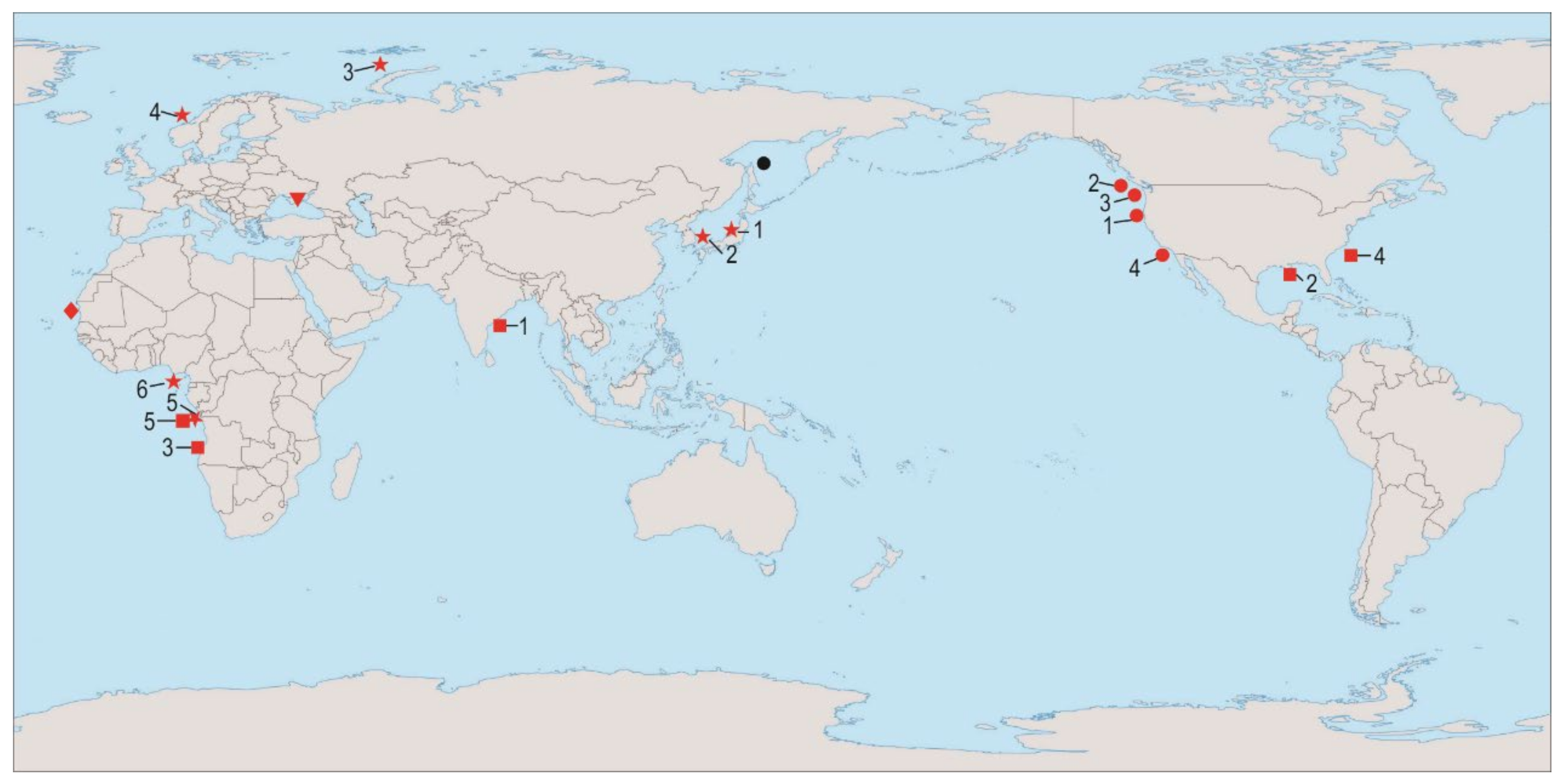
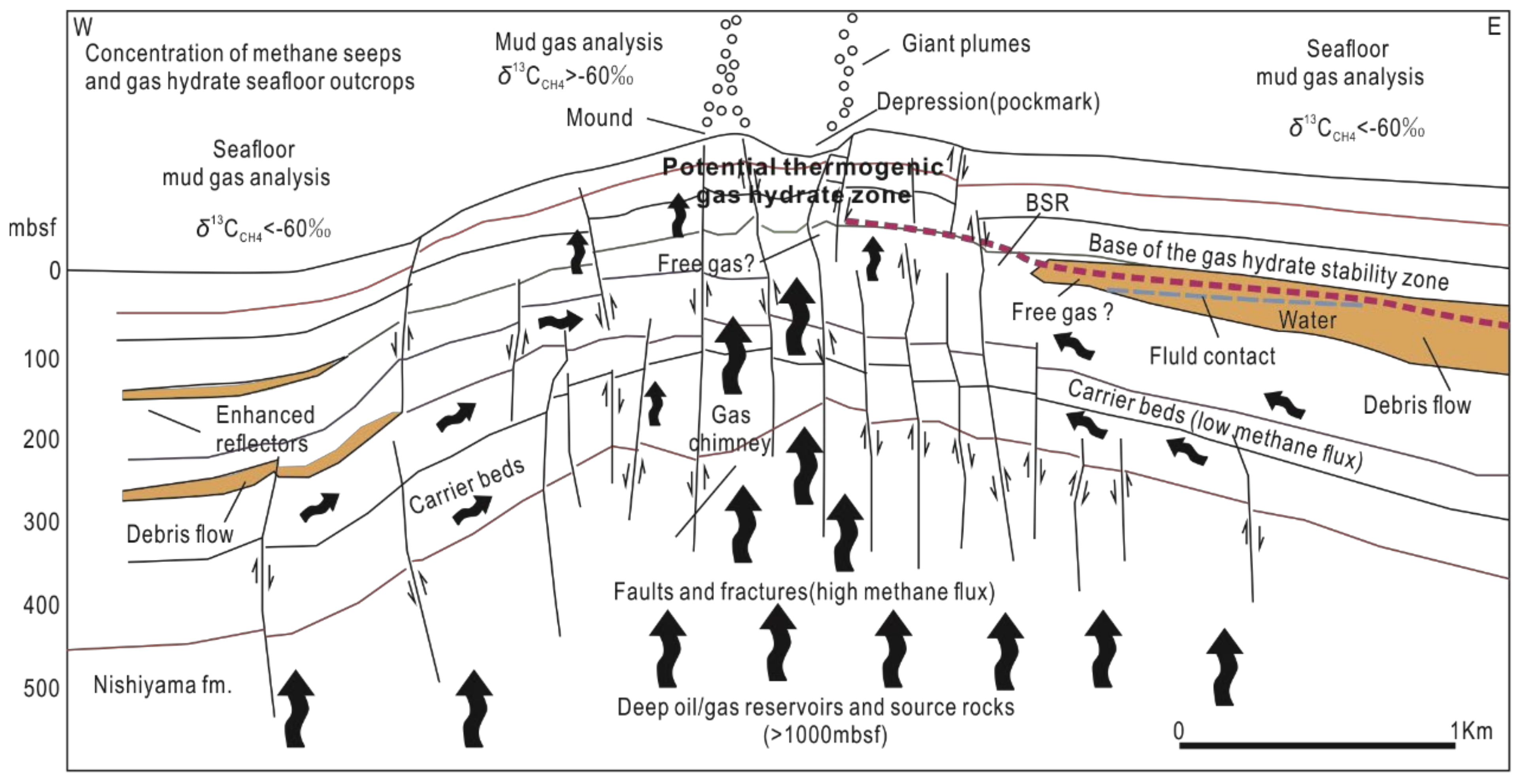
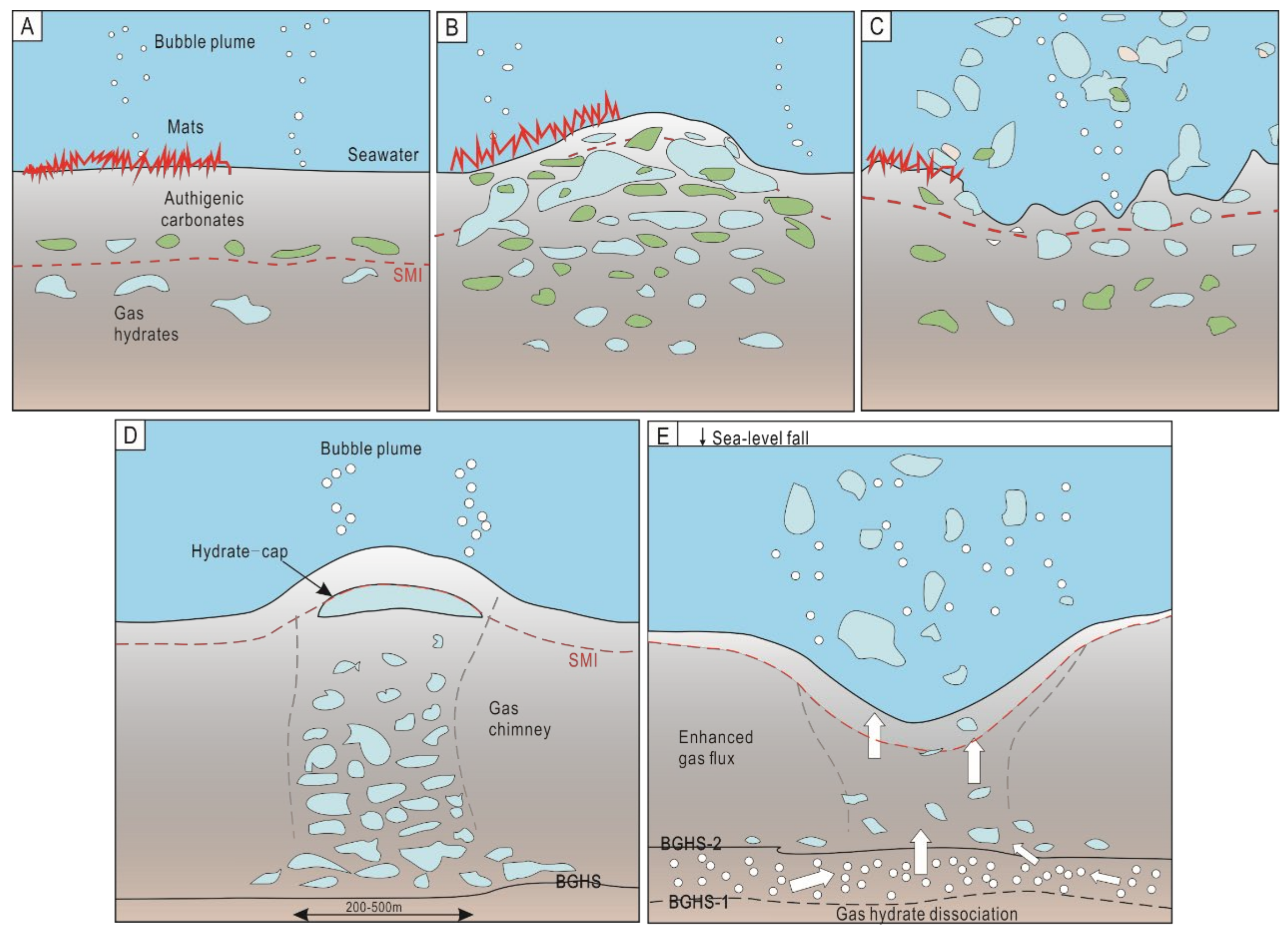
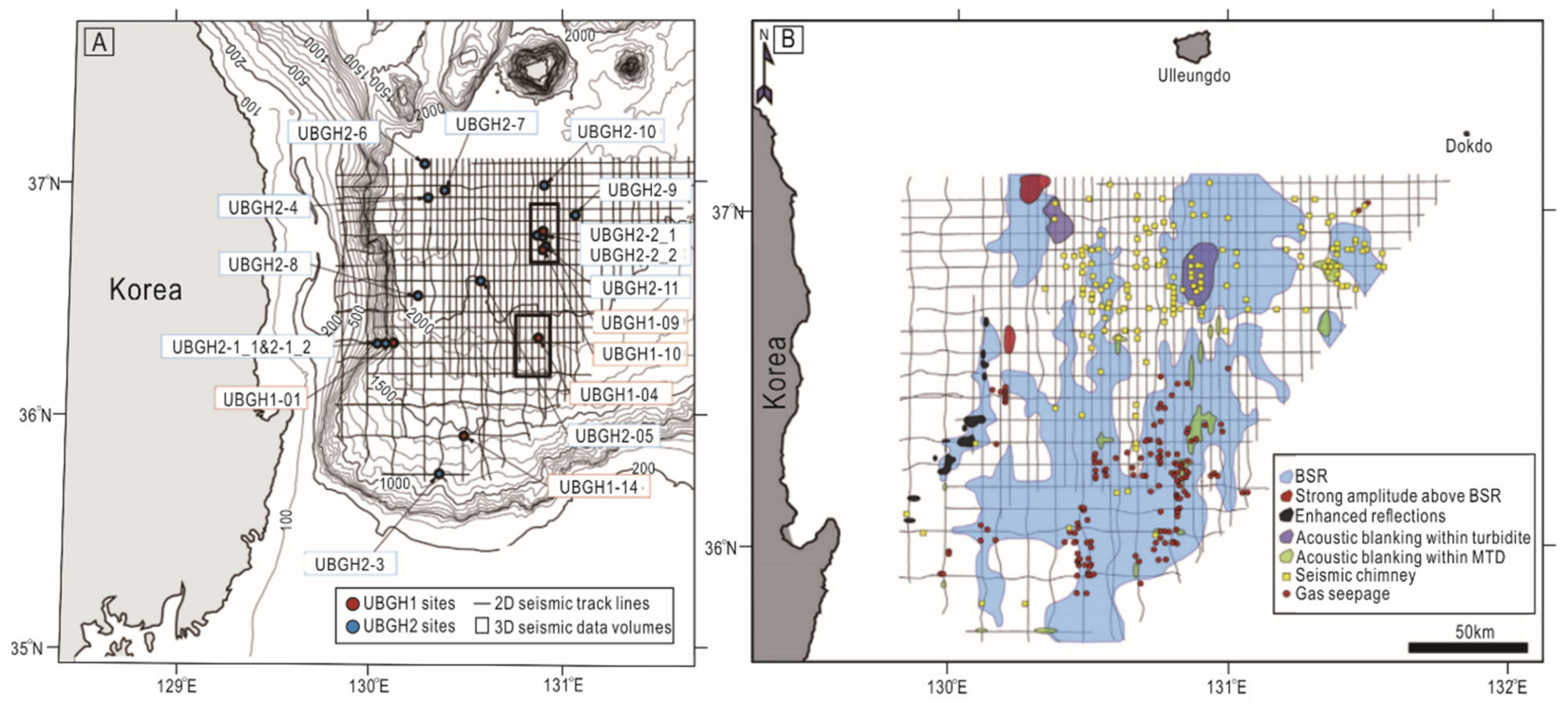
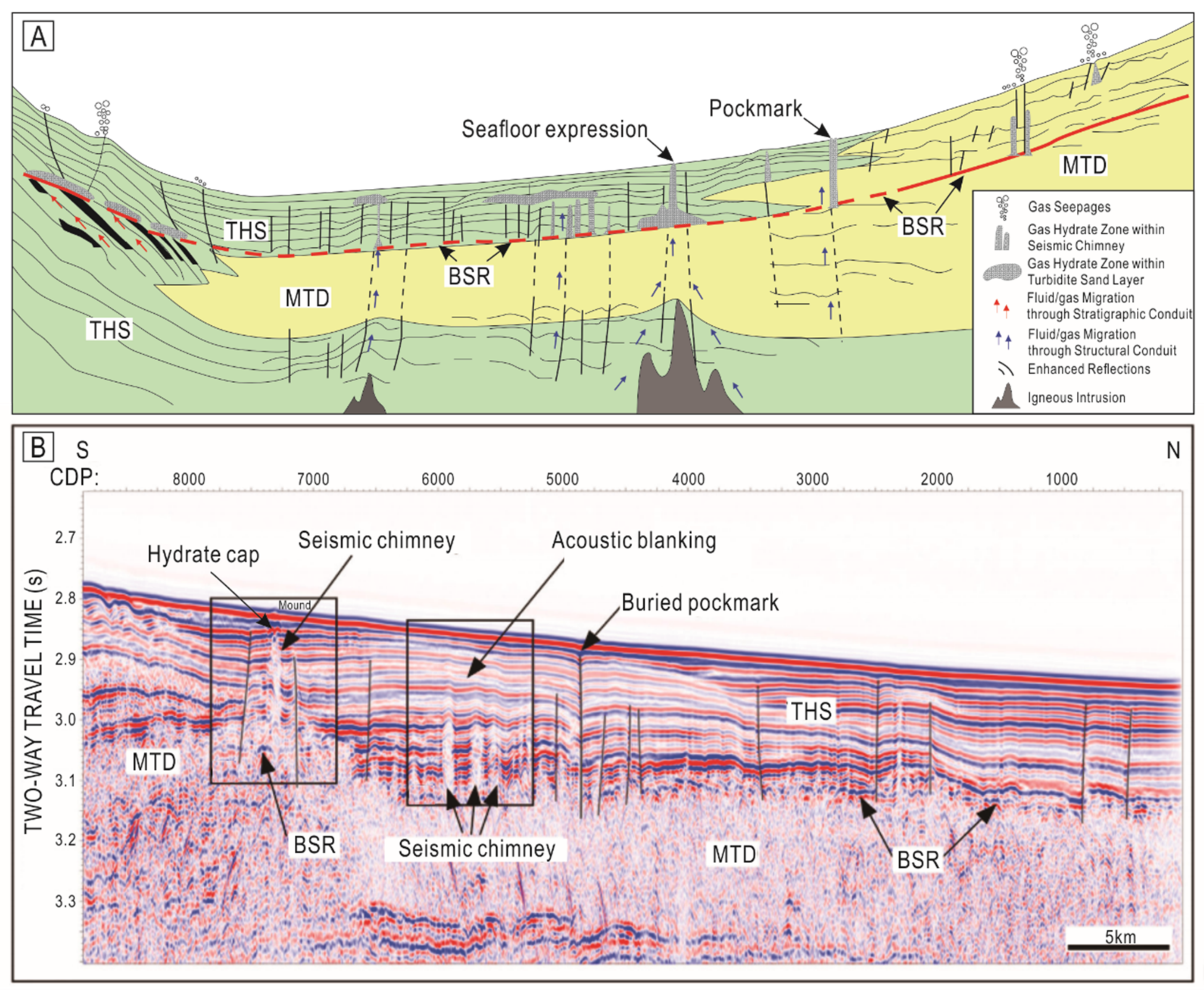



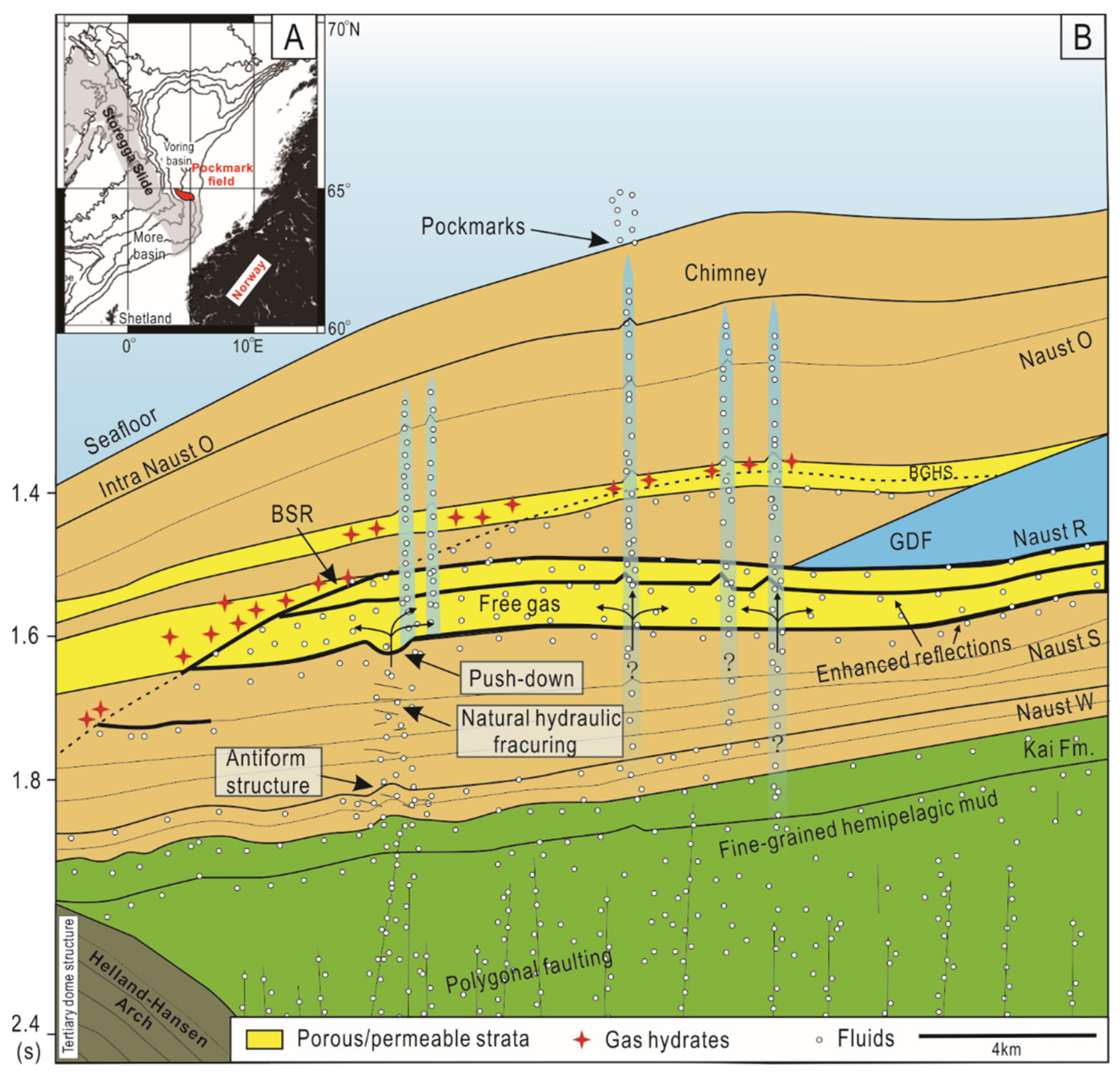
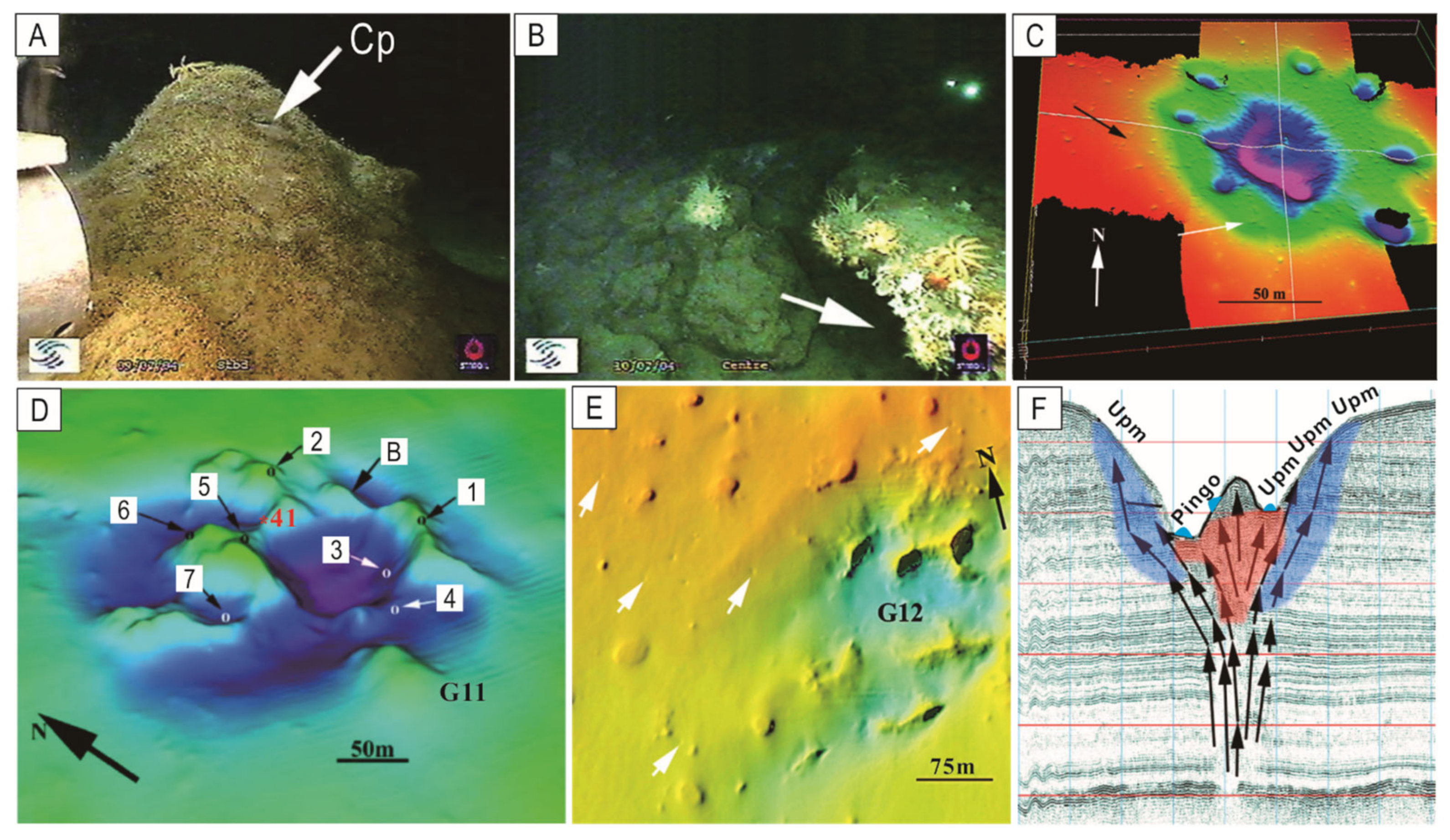
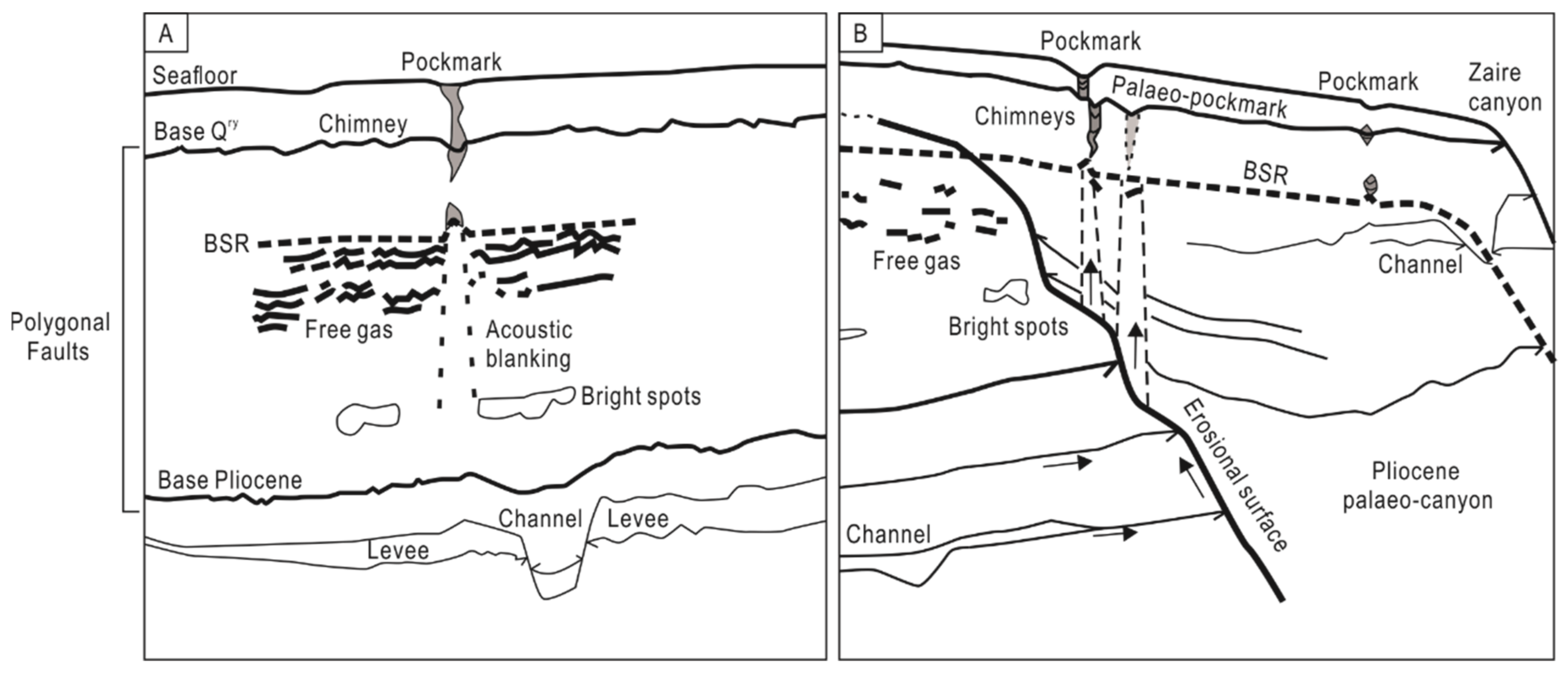
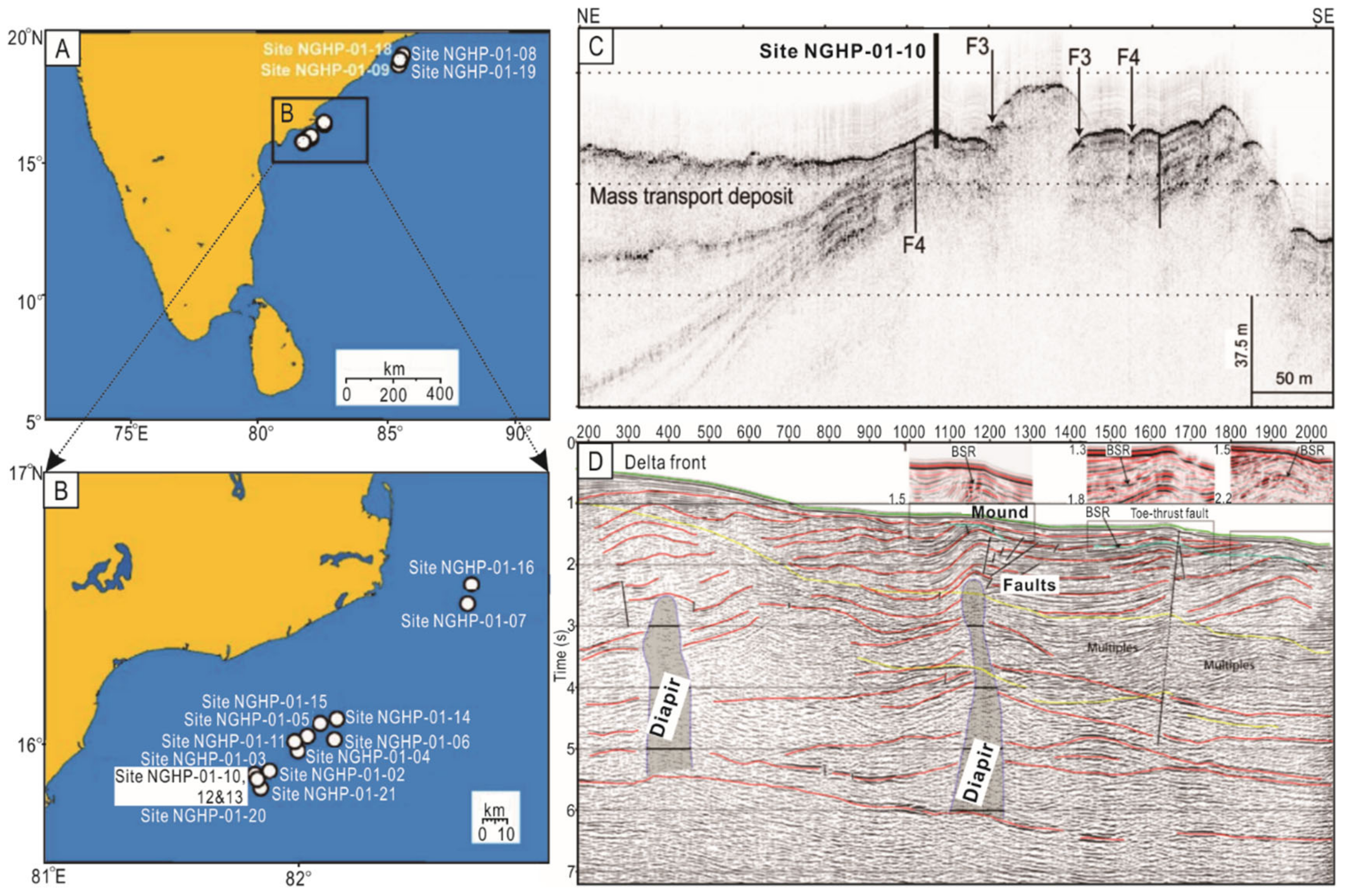
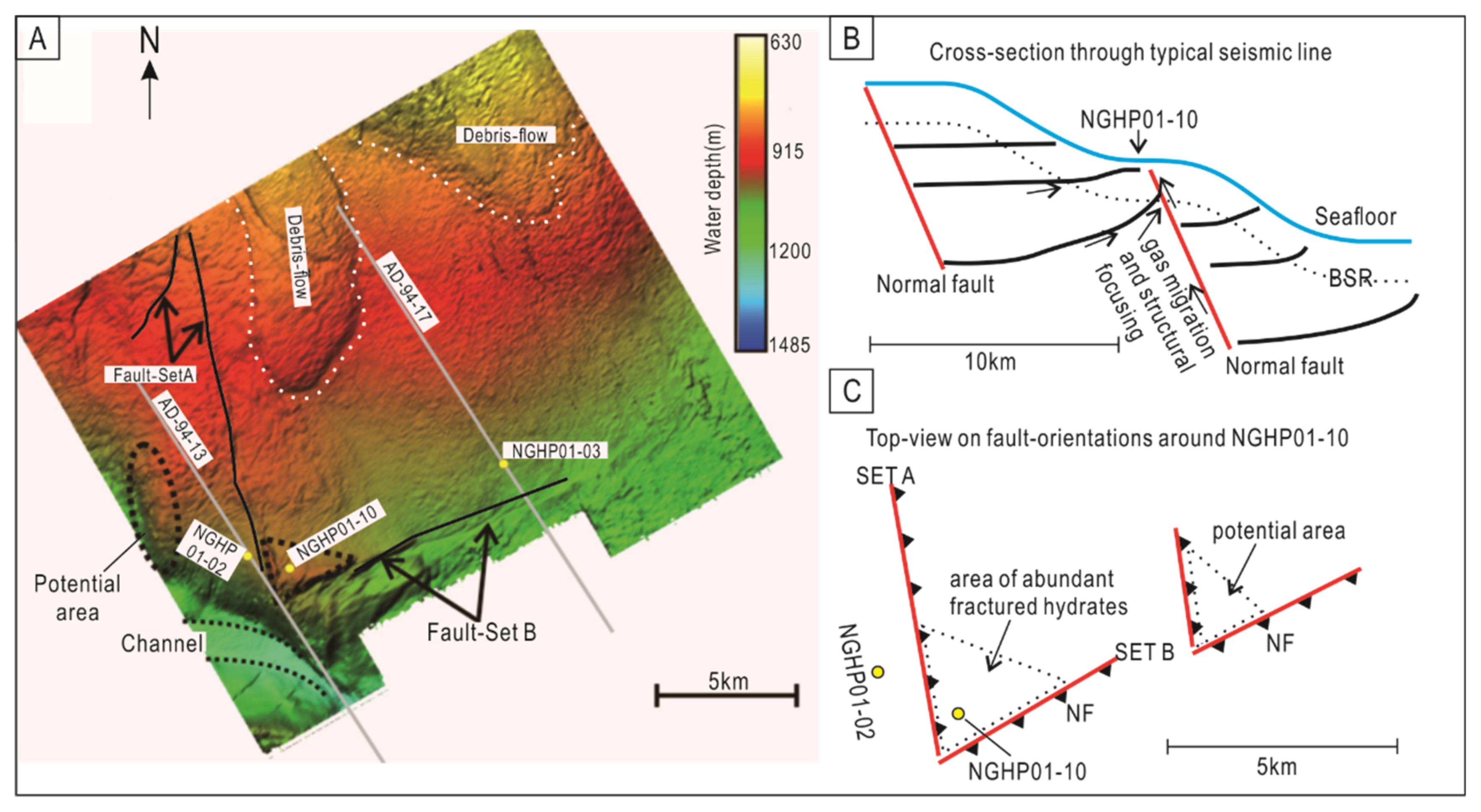



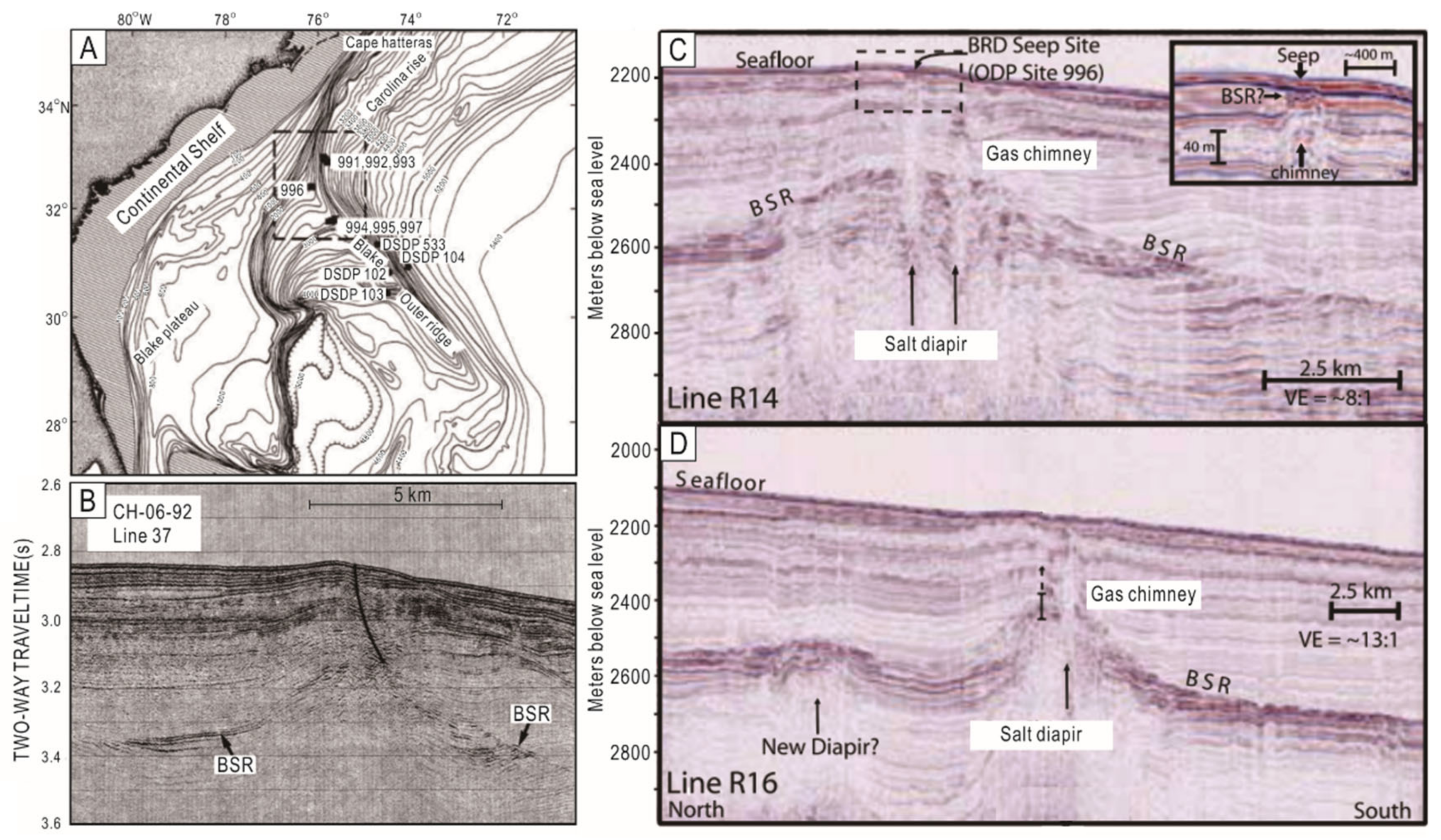


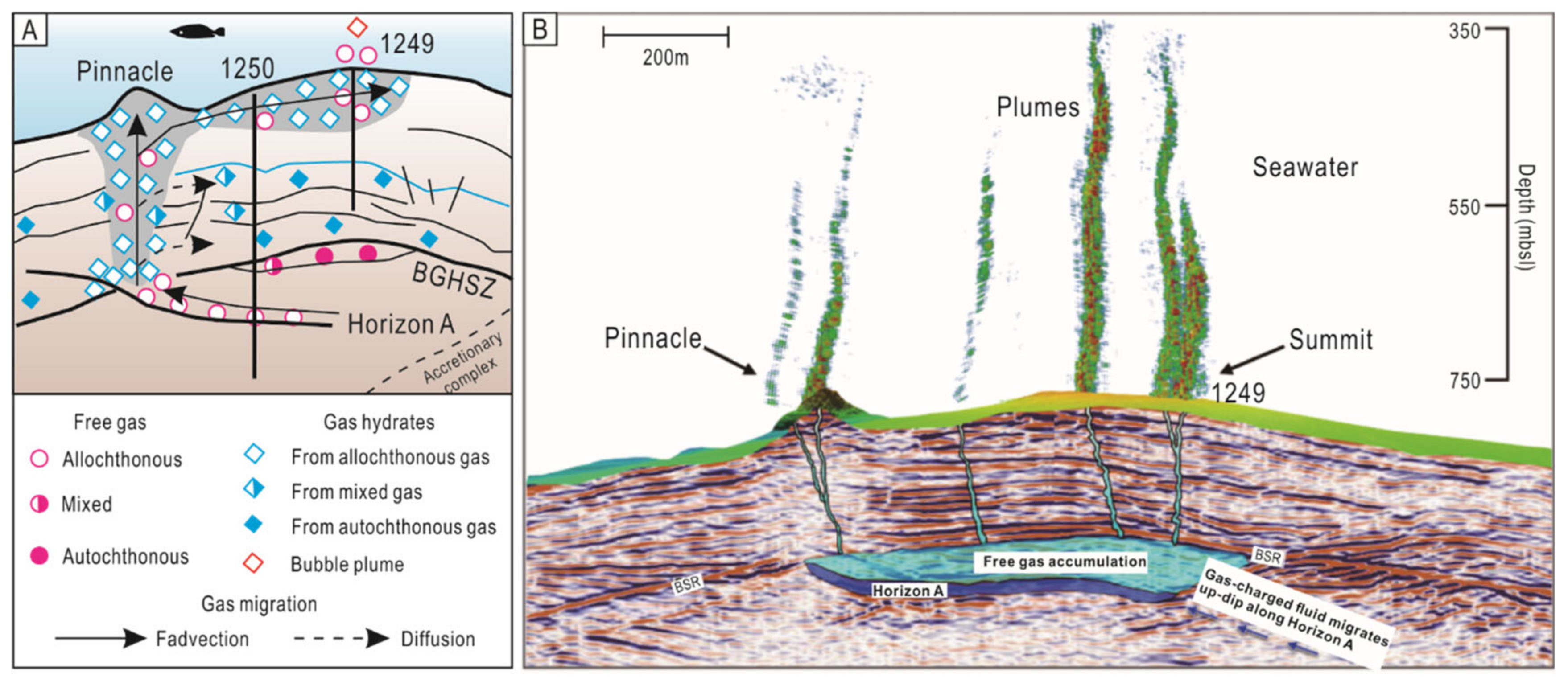





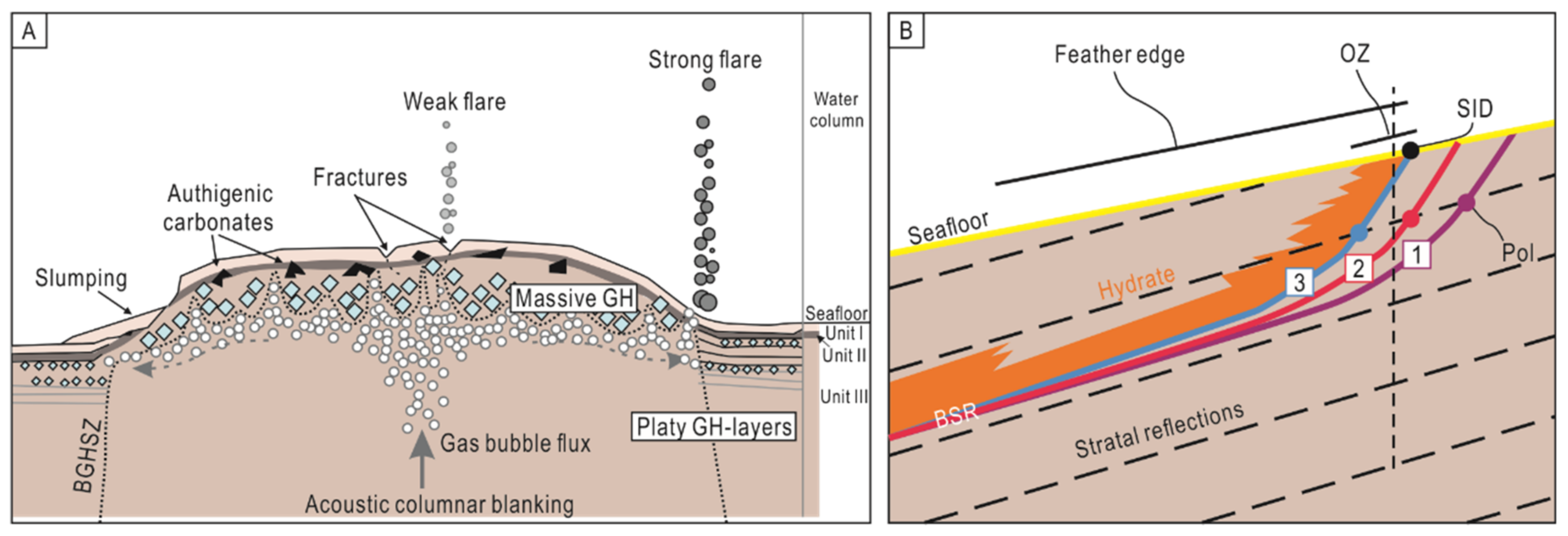
| Study Area | Migration Pathway | Hydrate Occurrence | Hydrate Types | Host Sediment | Hydrate Depth (mbsf) | Water Depth (m) | Bottom Water Temperature (°C) | Heat Flow (mW/m2) | Thermal Gradient (°C/km) | Gas Compositions | Gas Origins |
|---|---|---|---|---|---|---|---|---|---|---|---|
| Joetsu Basin, Japan | fault chimney | HM and SH | massive, nodular, and lenticular | clayed sediment | <100–120 | 1000 | 0.2–0.3 | — | 100 | nearly 100% CH4 | T |
| Ulleung Basin, Korea | fault chimney | SH | massive, fracture-filling, pore-filling, and disseminated | turbidite–hemipelagic sediment | <160–190 | 1800–2100 | 0.2–1.2 | 80–115 | 96–115 | mostly CH4 and traces of C2+ | M |
| Barents Sea | fault chimney | HM, SH, and MM | massive, veins, and lenses | fine-grained hemipelagic sediment | <61–160 | 360–390 | 2.0 | — | 30–50 | CH4 (99.63%), ethane (0.36%), and propane (0.01%) | T |
| Nyegga area, Norwegian Sea | fault chimney | HM, SH, and chunk | hydrate slabs | glacigenic debris flows | <300 | 600–750 | −0.7–−0.8 | — | 50–60 | CH4 (>99.30%) and traces of C2-C4 gases | M |
| KG Basin, India | diapir fault | SH | lenses, nodules, and fracture-filling | fine-grained mud | 26–160 | 1038 | 6.46 | — | 45 | CH4 (>99%) | M |
| Bush Hill, GoM | diapir fault | HM and SH | massive, veins, nodules, and interspersed layers | hemipelagic mud | <600 | 500–600 | 6.9–9.6 | — | 20 | C1-C5 gases | T |
| Offshore Angola | diapir fault | HM and SH | — | — | <40–70 | 630–1750 | 4.0 | — | 80 | — | T |
| Blake Ridge Diapir | diapir fault | SH and chunk | massive, cylindrical to round, platy, veins, and nodules | nannofossil-bearing clay | <50 | 2170 | 3.14 | — | — | CH4 (99%), traces of ethane, and other hydrocarbons | M |
| Southern Hydrate Ridge | fault/ fracture | SH | massive and porous | silty clay | <20–30 | 780 | 4.5 | — | 51 | CH4 (mostly) and traces of C2-C5 gases | T + M |
| Bullseye cold vent | fracture | SH | massive, nodules, veins, and fissures | fine laminated clay and silts | <20 (mainly) | 1272 | 3.2 | 58 | 54 (889 Site) | mostly CH4, some H2S and CO2, and <0.5% heavier hydrocarbons | M |
| Barkley Canyon | fault/ fracture | HM | massive | silty mud | — | 870 | 3.0 | — | — | CH4 and C2-C5 gases (14.90~31.90%) | T |
| HMMV | mud volcano | SH | veins and subrounded aggregate | fine-grained mud | <3.0 | 1257 | 40 (crater) | — | 300 (crater) | C1-C4 (CH4 through butanes) hydrocarbons | M + T |
Publisher’s Note: MDPI stays neutral with regard to jurisdictional claims in published maps and institutional affiliations. |
© 2022 by the authors. Licensee MDPI, Basel, Switzerland. This article is an open access article distributed under the terms and conditions of the Creative Commons Attribution (CC BY) license (https://creativecommons.org/licenses/by/4.0/).
Share and Cite
Liu, L.; Chu, F.; Wu, N.; Zhang, L.; Li, X.; Li, H.; Li, Z.; Zhang, W.; Wang, X. Gas Sources, Migration, and Accumulation Systems: The Shallow Subsurface and Near-Seafloor Gas Hydrate Deposits. Energies 2022, 15, 6921. https://doi.org/10.3390/en15196921
Liu L, Chu F, Wu N, Zhang L, Li X, Li H, Li Z, Zhang W, Wang X. Gas Sources, Migration, and Accumulation Systems: The Shallow Subsurface and Near-Seafloor Gas Hydrate Deposits. Energies. 2022; 15(19):6921. https://doi.org/10.3390/en15196921
Chicago/Turabian StyleLiu, Liping, Fengyou Chu, Nengyou Wu, Lei Zhang, Xiaohu Li, Huaiming Li, Zhenggang Li, Weiyan Zhang, and Xiao Wang. 2022. "Gas Sources, Migration, and Accumulation Systems: The Shallow Subsurface and Near-Seafloor Gas Hydrate Deposits" Energies 15, no. 19: 6921. https://doi.org/10.3390/en15196921
APA StyleLiu, L., Chu, F., Wu, N., Zhang, L., Li, X., Li, H., Li, Z., Zhang, W., & Wang, X. (2022). Gas Sources, Migration, and Accumulation Systems: The Shallow Subsurface and Near-Seafloor Gas Hydrate Deposits. Energies, 15(19), 6921. https://doi.org/10.3390/en15196921








